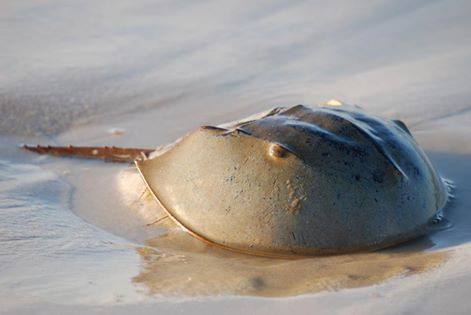Horseshoe crabs have withstood the test of time. Fossils of horseshoe crab ancestors date back to ar
Horseshoe crabs have withstood the test of time. Fossils of horseshoe crab ancestors date back to around 450 million years ago, which is over 200 million years before dinosaurs started their rise to superstardom. The crab portion of the horseshoe crab’s name is deceptive. They are more closely related to arachnids (spiders and scorpions) than they are to crustaceans (true crabs, lobsters and shrimp). Horseshoe crabs have an important role in our lives that extends beyond finding their empty shells washed up on beaches. The biomedical industry utilizes their blood on an industrial sized scale.Horseshoe crabs have bright blue blood because they use copper based hemocyanin to transport oxygen, which differs from vertebrates who use iron-based hemoglobin. Vertebrates use white blood cells to fight infection, whereas many invertebrates, like the horseshoe crab, use amebocytes. The amebocytes of the Atlantic horseshoe crab (Limulus polyphemus) may have played an integral part in allowing the horseshoe crab to thrive and survive for millions of years.The amebocytes in horseshoe crab blood identify and coagulate around contaminant bacteria. Capable of detecting bacteria at levels of one part per trillion, these amebocytes are of great value in the biomedical industry. Humans use the blood to test the sterility of medical equipment and virtually all intravenous drugs. Over 600,000 crabs are captured each year and each crab has about 30% of its blood withdrawn. Between 10% and 30% of crabs that give blood die. The world’s largest population is in Chesapeake Bay and over the last 15 years numbers have been reduced by between 75 % and 90%.Alternative methods for detecting sterility are being researched and developed, but for the time being it is important to protect the horseshoe crab population. They have withstood the test of time, but can they withstand the test of humans? Only time will tell.KKSGeneral Horseshoe crab info: http://bit.ly/1D9kZp1HS Crab blood reading: http://bit.ly/1sVMSskPhoto by Brian Switek -- source link
Tumblr Blog : the-earth-story.com
#horseshoe crab#medicine#oxygen#blood#copper#amebocyte#coagulate#bacteria#pharmaceutical#biomedical
